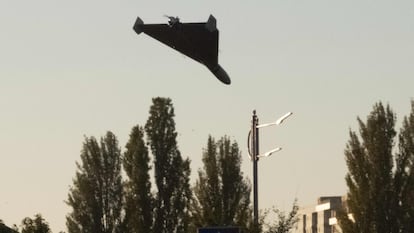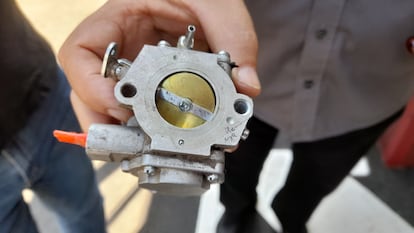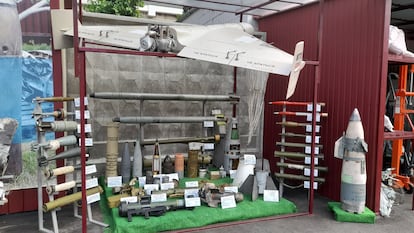The missiles Russia deploys against Ukraine have Western parts
Most of Moscow’s shells, drones, vehicles and artillery rely on electronic components from foreign companies. The involvement of intermediaries and a lack of export controls allow such trade to happen


As Oleksi Kuzmenko, 52, is explaining how to investigate the scene of a crime perpetrated by a Russian missile, a fellow lab veteran interrupts with a piece of one in his right hand. He wants to show that the tennis-ball-sized item he is holding — and with which he was fiddling with his tools a moment ago — is the carburetor from a Shahed drone. This unmanned device is manufactured in Iran, but that specific part is of Japanese origin. “We found this out a few weeks ago,” Kuzmenko points out. It is one of the latest findings to show that the weapons Russia uses to punish Ukrainian citizens — cruise missiles, hypersonic missiles, drones, launchers, tanks, helicopters — have components manufactured in Western countries. This occurs for two reasons: a convoluted labyrinth of intermediaries that circumvents Washington and the EU’s sanctions against this business, and Kyiv’s allies’ deficient export control system.
Japan is just one example, albeit a remarkable one, because Moscow has already launched about 2,000 Shahed drones against Ukrainian territory, typically in civilian areas, since the invasion began. A recent report prepared by the Kyiv School of Economics (KSE) analysis center, in collaboration with the Yermak-McFaul Group —Russia’s Military Capacity and the Role of Imported Components — states that out of a sample of 58 weapons, they found that 67% of the foreign components were produced by American companies, 7% by Japanese companies and 7% by German companies. As the KSE argues, that does not necessarily mean that the manufacturer of the parts knows how the material will ultimately be used. From origin to assembly in Russia, dozens of intermediaries may have been involved.

Kuzmenko works at the Scientific Forensic Research Institute in Kyiv. Just minutes after a Kinzhal (hypersonic) missile was intercepted in the sky over the Ukrainian capital by Patriot air defense systems, the chief lab technician shows a recently collected missile head, which has been placed on AstroTurf as part of a showcase of horrors: a nearly intact Shahed, which missed its target and fell; the remains of a cruise missile; a Tochka-U like the one that blew up the Kramatorsk train station; the remains of a missile with cluster munitions; and even decoys intended to confuse anti-aircraft defenses.
“This comes from Italy, this is Chinese, this is American, this microchip was produced in Switzerland,” the forensic expert explains, holding the controller of an Iranian drone in his hand, at one of the laboratory tables where they take apart the items found at the impact site. “It’s easy to buy these components anywhere and assemble them in Russia,” he observes. After an attack, this institute sends a team to the crime scene to collect the evidence; then, they take it to the lab, analyze it, look at the registration numbers, compare it with other samples, label it and send it to the police, who deliver it to the courts.
China as an intermediary
Now, Kuzmenko is showing a Kalibr cruise missile, which Russia launches from the Black Sea Fleet. “All the electronic components of this one are Western,” he says. These Kalibr missiles are also part of the sample of Russian military equipment analyzed by the KSE, along with other missiles such as the KH-59, the Iskander and the KH-101. According to the KSE’s examination, the vast majority of the Western-made components are microchips. The electronic parts (semiconductors, microprocessors, microtransistors) of these weapons generally originate in countries to the west of the Carpathians. Russia does not have the capacity to produce them. “We have to distinguish two things,” says Olena Bilousova, 30, one of the authors of the KSE report. “First, there is the country where the manufacturing company is based, which may be the United States, and then the final producer, which may be in China, Malaysia or the Philippines. The product does not have to enter the U.S. and is not under its export control.”
The KSE has traced the trade routes of the components of these 58 pieces of Russian military equipment. In its analysis, the KSE found 1,057 components produced by 155 companies based in 19 countries. Most come from the United States, followed by Japan and Germany, then Switzerland, Taiwan, the Netherlands and China. But the Asian giant stands out as a leading intermediary country, along with Hong Kong and Turkey; these components end up traveling from those countries to Russian trading partners.
But the casuistry involved in this process is as varied as the international trade routes are. The KSE report points out that they have also found numerous electronic components in ballistic or cruise missiles that were initially intended for the Russian space program (Roscosmos). In other words, they were meant to fulfill a non-military purpose. The report states that “Roscosmos has been used by Russia as a means of acquiring technologies with both civilian and military applications.” Bilousova is calling for sanctions to be applied more decisively and quickly to control trade: “We have to be able to cut off new routes to stop this monster [and] force Russia to think of new ways to obtain these components, which will be more expensive, [meaning they will] have less money for war.”

Volodymir Zelenskiy’s government is still working to accomplish that by engaging in regular talks with those responsible for applying sanctions in countries allied with Ukraine. Vladislav Vlasiuk, 34, is the advisor to Head of the Office of the President of Ukraine, Andri Yermak. Not very happily, Vlasiuk acknowledges that Russia still has the resources and materials to add to its arsenal. Born in the Vinitsia region, the lawyer points out that, since June, the European Union has had the ability to punish the countries that help Moscow circumvent the sanctions, including intermediaries who sell Western components. But things are moving slowly. “Maybe,” he reflects with a smile, “we should publicize the [names of the] companies that manufacture these parts.”
From an internal report, Vlasiuk takes out the photograph of a microchip used by a Russian cruise missile and manufactured by a well-known American company. Vlasiuk also collaborates with the Yermak-McFaul Group, which works on imposing Western sanctions. He has met with nearly everyone to persuade them that they need to apply more pressure. A few weeks ago, he met with the Chinese diplomat, Li Hui, who denied that Beijing had sold any parts to the major Russian arms factory. Xi Jinping’s representative added that it was another matter if private Chinese companies were responsible for selling the parts. “In spite of everything,” the advisor concludes, “without thinking about how everything would be in a world without sanctions, we have come to the conclusion that they are effective.”
Back at the forensic institute, Kuzmenko shares an anecdote: “At first, the Russians sent the Iranian Shahed with a phrase in Russian that said, ‘do not touch’; they were trying to deceive the world.” Now, the forensic technician warns, this model of unmanned device comes with Russian registration numbers, indicating that they may come from the new drone factory that Moscow built in the Republic of Tatarstan.
Follow all the international news on Facebook and Twitter, or in our weekly newsletter.
Tu suscripción se está usando en otro dispositivo
¿Quieres añadir otro usuario a tu suscripción?
Si continúas leyendo en este dispositivo, no se podrá leer en el otro.
FlechaTu suscripción se está usando en otro dispositivo y solo puedes acceder a EL PAÍS desde un dispositivo a la vez.
Si quieres compartir tu cuenta, cambia tu suscripción a la modalidad Premium, así podrás añadir otro usuario. Cada uno accederá con su propia cuenta de email, lo que os permitirá personalizar vuestra experiencia en EL PAÍS.
¿Tienes una suscripción de empresa? Accede aquí para contratar más cuentas.
En el caso de no saber quién está usando tu cuenta, te recomendamos cambiar tu contraseña aquí.
Si decides continuar compartiendo tu cuenta, este mensaje se mostrará en tu dispositivo y en el de la otra persona que está usando tu cuenta de forma indefinida, afectando a tu experiencia de lectura. Puedes consultar aquí los términos y condiciones de la suscripción digital.
More information
Archived In
Últimas noticias
Most viewed
- Reinhard Genzel, Nobel laureate in physics: ‘One-minute videos will never give you the truth’
- Oona Chaplin: ‘I told James Cameron that I was living in a treehouse and starting a permaculture project with a friend’
- Pablo Escobar’s hippos: A serious environmental problem, 40 years on
- Why we lost the habit of sleeping in two segments and how that changed our sense of time
- Chevy Chase, the beloved comedian who was a monster off camera: ‘Not everyone hated him, just the people who’ve worked with him’










































